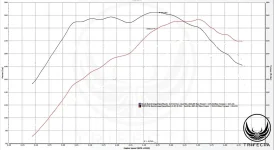Shortly after I bought my used Regal Tour-X, I purchased the Trifecta canned tune which claims to add ~40 hp / 40 tq at the wheels. The dyno sheet is attached, and for clarity, I removed the stock graph.
I compare this to a vehicle I used to own (sedan) that I had custom tuned at a shop after installing some very inexpensive mods. Both weigh within 100lb of each other, and in my experience, within 1-2 mpg of each other.
I know there's a hundred variables like gear ratios and such, but for fun's sake the Tour-X is AWD and an 8-speed transmission, the latter dyno graph is an older (early 00's) FWD with a 4-speed auto.
Which would be faster? Bonus to whoever can guess the powertrain of the older car.
I compare this to a vehicle I used to own (sedan) that I had custom tuned at a shop after installing some very inexpensive mods. Both weigh within 100lb of each other, and in my experience, within 1-2 mpg of each other.
I know there's a hundred variables like gear ratios and such, but for fun's sake the Tour-X is AWD and an 8-speed transmission, the latter dyno graph is an older (early 00's) FWD with a 4-speed auto.
Which would be faster? Bonus to whoever can guess the powertrain of the older car.


